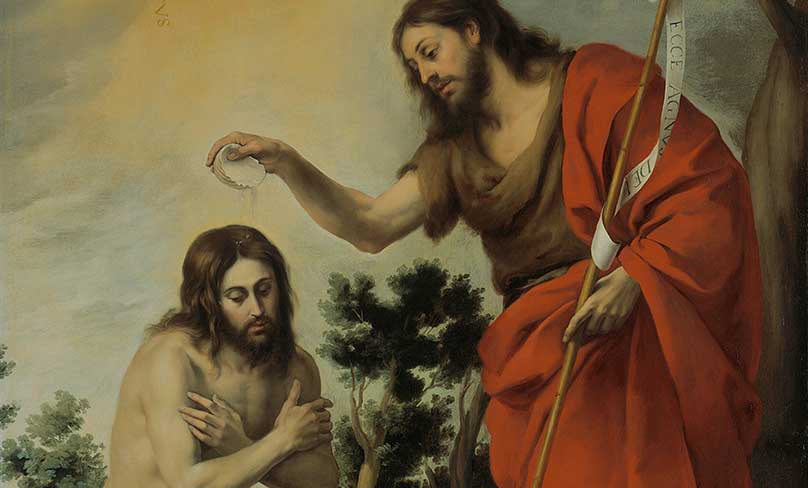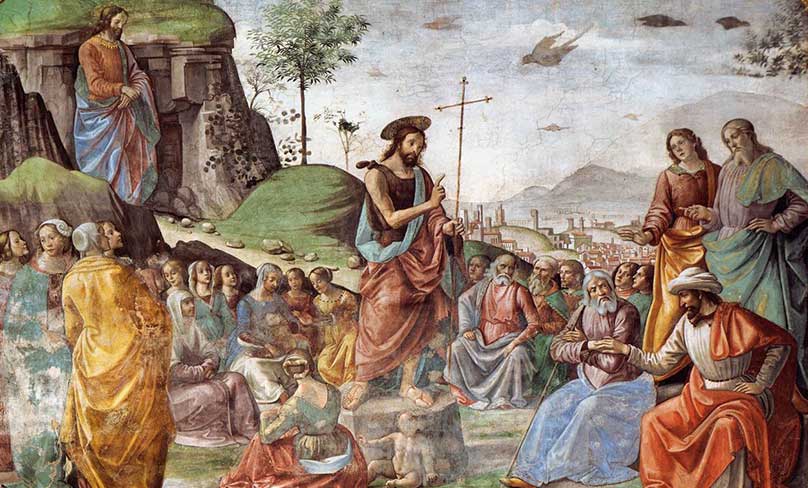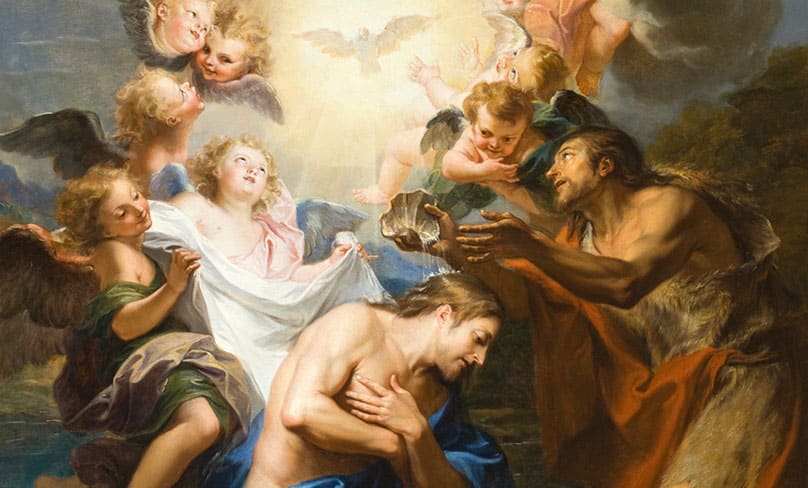
This is Part 2 of Mark’s series for Advent of St John the Baptist. Click here for Part 1.
John the Baptist baptised. That is the core fact we know about him. Aside from the occasional painting of his head on a platter, every piece of artwork we have shows him baptising people. This is one of the curious features of the sparseness of both the biblical narrative and of religious iconography. Later figures will be shown in a more 3D way. We will see Abraham Lincoln not simply giving the Gettysburg Address in every image, but playing with his kids, splitting rails, telling bawdy jokes and fighting with his cabinet. But biblical figures like John are reduced down to the distilled essence of their mission. John baptised. He exists in our minds, forever standing at the banks of Jordan, pouring water on sinners, exhorting them to repent, and announcing that there is One coming after him whose sandals he is not worthy to untie, who will baptise, not with water, but with the Spirit and fire.
Indeed, baptism is so identified with his John’s mission that some people wonder if John invented baptism.
He did not.
John was a Jew. Jews had practiced ritual ablutions for ages before John came along. The Old Testament had a long tradition of associating ritual impurities with sin. It is what I call the “Ick Factor”. All cultures have an Ick Factor, including ours. If you don’t believe me, try sitting down to a nice bowl of squirming larvae for dinner. Different cultures find different things to be icky, but all cultures find something icky and most cultures find much of the same things icky.
Jewish culture was no different and so practiced mikveh or ritual ablutions for purification from things like contact with blood, semen, menstruation, skin infections, or dead bodies (among other things). And given the intensely sacralized imagination of the Old Testament authors, ritual impurity was easily transmuted into an image of moral and spiritual impurity. Just as icky things could lead to diseases that spread, rot, defile, and kill, so too sin could do the same thing to the soul. So Jewish culture wound up enshrining a habit of washings and ablutions that were both pious acts and, by good Providence, excellent hygiene as well.
John the Baptist took this pious custom from Jewish culture and, if you will, re-purposed it. The washing he offered was, as Scripture describes it a “baptism of repentance for the forgiveness of sins” (Mark 1:4). This was not a washing that aimed to purify the body of ritual defilement but was, instead, a sign of a conscience seeking cleansing. It was not, by the way, sacramental baptism either. John is, recall, a sort of hinge figure in the passage from the Old Covenant to the New. Sacramental baptism, which actually has the power to cleanse from sin, was only established with the death and resurrection of Jesus. In John’s day, his baptism was, like the rest of his ministry, a foreshadow of the sacrament, not the sacrament itself.
The interesting thing is that John inspired imitators. This is alluded to by the Gospel of John the Evangelist in a sort of haphazard way when he notes that both Andrew and he were John’s disciples before John referred them to Jesus (John 1:35-37) and that “After this Jesus and his disciples went into the land of Judea; there he remained with them and baptised” (John 3:22). The Evangelist then clarifies further that “Jesus was making and baptising more disciples than John (although Jesus himself did not baptise, but only his disciples)” (John 4:1-2).

The picture that emerges is that of John the Baptist’s disciples first taking up his work of baptism and then, as they turned to follow Jesus, taking that custom with them and baptising Jesus’ followers with the baptism of John and calling them to repentance as John had done. Given that Jesus’ initial proclamation was “Repent, for the kingdom of God is near!” (Matthew 3:2) this is entirely understandable. Indeed, for many of John’s disciples, it was difficult to distinguish between John’s message and that of Jesus. In fact, a cult grew up around John the Baptist that regarded him, not Jesus, as the main event. So Acts 19 tells us:
While Apollos was at Corinth, Paul passed through the upper country and came to Ephesus. There he found some disciples. And he said to them, “Did you receive the Holy Spirit when you believed?” And they said, “No, we have never even heard that there is a Holy Spirit.” And he said, “Into what then were you baptized?” They said, “Into John’s baptism.” And Paul said, “John baptized with the baptism of repentance, telling the people to believe in the one who was to come after him, that is, Jesus.” On hearing this, they were baptized in the name of the Lord Jesus. And when Paul had laid his hands upon them, the Holy Spirit came on them; and they spoke with tongues and prophesied. There were about twelve of them in all. (Acts 19:1-7)
John the Evangelist, also writing for the community at Ephesus decades after Paul’s encounter with this group, will still have to confront the challenge of this sect that gives John the Baptist primacy over Jesus. That’s why his gospel will repeatedly hammer away at the fact that John the Baptist “came for testimony, to bear witness to the light, that all might believe through him. He was not the light, but came to bear witness to the light” (John 1:7-8), that “He confessed, he did not deny, but confessed, ‘I am not the Christ’” (John 1:20), that he urged his disciples to follow Jesus as the Son of God (John 1:29-34), and that he insisted, “He who has the bride is the bridegroom; the friend of the bridegroom, who stands and hears him, rejoices greatly at the bridegroom’s voice; therefore this joy of mine is now full. He must increase, but I must decrease.” (John 3:29-30).
The point is that John is no mere moral reformer to be followed for his own sake. He and Jesus both call us to repentance because the kingdom of heaven is near. But John speaks as the herald of the king while Jesus speaks as the king himself.
And that brings us to one of the most awkward facts about the gospel: the baptism of Jesus. It’s one of the stories in the gospels that demonstrates the honesty of the evangelists since the obvious question that arises is “Why would the sinless Son of God need to be baptized for repentance and the forgiveness of sins?” It practically begs to be read as many modernists do read it: a sort of tale from the early days of the merely human Jesus who, like every other sinner, needed forgiveness and sought it from John. It’s the kind of thing that critics of Christianity immediately gravitate towards in order to “prove” that Jesus was merely a human rabbi whose followers then elevated him to a god later on.

The thing is, those followers are all careful to include this story instead of do what dishonest people do and just scissor it out of the gospels? Why?
The baptism narrative tells us why:
Then Jesus came from Galilee to the Jordan to John, to be baptized by him. John would have prevented him, saying, “I need to be baptized by you, and do you come to me?” But Jesus answered him, “Let it be so now; for thus it is fitting for us to fulfil all righteousness.” Then he consented. And when Jesus was baptized, he went up immediately from the water, and behold, the heavens were opened and he saw the Spirit of God descending like a dove, and alighting on him; and behold, a voice from heaven, saying, “This is my beloved Son, with whom I am well pleased.” (Matthew 3:13-17)
Jesus does not come to John to repent his sins since he has no sins to repent. He come to John to identify himself with the whole sinful human race and bear our sins. His baptism is the foreshadow of the death Jesus will undergo for us. As he later asks his disciples, who imagine his kingship will be one of earthly power, “Are you able to drink the chalice that I drink, or to be baptised with the baptism with which I am baptised?” (Mark 10:38). The baptism of John is the sign of the drowning in pain and death he will undergo at the climax of his ministry—for the sake of all who, like John’s disciples, are seeking to die to sin and live in the freedom of the children of God.
God himself confirms this as he speaks from heaven, and John will go to his grave affirming Jesus is the One for whom he was sent as a herald.
But not without a struggle, of which more next time.
